ARA in Baby Formula: Everything you Need to Know
Is ARA the secret sauce for super baby development? Our experts give us the scoop!

Mommyhood101 independently tests and curates baby gear to help you make informed decisions. If you buy products through links on our site, we may earn a commission.
Arachidonic acid (AA or ARA) is one of many essential fatty acids that play a vital role in human development.
For infants, ARA is crucial for proper growth and development of the nervous system and immune function.
When ARA is used in baby formula, it is added in an attempt to mimic the ARA levels naturally found in breast milk.
In this article, we dive deep into ARA, helping you decide which sources might be right for your little one.
-
- What is ARA?
- ARA in Baby Formula
- Benefits of ARA for Infants
- Cognitive Development
- Visual System Development
- Physical Development
- Immune System Support
- Sources of ARA in Baby Formula
- Hexane in ARA Extraction
- How Much ARA Should be in Baby Formula?
- ARA in Baby Formula versus Breast Milk
- Side Effects & Precautions
- Storage & Handling
- Conclusions
- Scientific References
Once you finish reading this article, be sure to check out our reviews of the best organic baby formulas, all of which use thoughtfully sourced ARA.
What is ARA?
ARA stands for arachidonic acid.
ARA is a long-chain polyunsaturated omega-6 fatty acid primarily found in animal-based foods. These include red meat, poultry (chicken, turkey), eggs, seafood (salmon, trout, shrimp), and full-fat dairy products like whole milk and cheese.
ARA is called an "essential" fatty acid because the human body cannot produce sufficient levels of ARA by itself. That means it is obtained primarily from dietary sources.

There are also a few vegetarian and vegan ARA sources, including algae, seeds (flaxseeds, chia seeds, hemp seeds), and nuts (walnuts, pecans). The ARA content of seeds and nuts is relatively low.
As an Omega-6, ARA is a healthy fat (polyunsaturated fatty acid) that has diverse effects on health-related outcomes in both children and adults.
This includes fetal and infant health and development:
- During pregnancy, ARA accumulates in the fetus (including in the fat tissue and brain), provided through the mother's diet, and transferred across the placenta.
- During breastfeeding, ARA constitutes about 0.5% of the fatty acid content in breast milk, and the infant brain continues to accumulate ARA during the perinatal period and early infancy.
You won't be surprised to learn that ARA is also included in baby formula to mimic the levels found in breast milk.
ARA in Baby Formula
Because ARA is prevalent in breast milk, it tends to be included in most baby formulas.
In the United States, the Food and Drug Administration's (FDA) regulations do not mandate the inclusion of ARA in baby formula.
The FDA does, however, mandate the inclusion of a different Omega-6 fatty acid, linoleic acid (LA).
Linoleic acid is abundant in human breast milk, comprising about 10% of its fatty acid content. While LA does get converted in the body to ARA, the conversion rate is insufficient to sustain adequate ARA levels in the body.
Because the United States does not mandate ARA inclusion, it is also not required to be disclosed in the nutrition facts. This makes it challenging to know exactly how much ARA is included in most U.S. baby formulas.
In Europe, the European Commission does not require infant formulas to contain ARA.
This is in contrast to their policy concerning DHA, which is mandatory in all infant formulas (at 0.33-1.14% of total fat).
While ARA is not required to be included in the USA or Europe, it is typically found in infant formula. Here are two examples:

In the above image, on the left (Earth's Best Organic Baby Formula) you can see Mortierella Alpina Oil (often called M. Alpina), which is a fungal source of ARA.
On the right (Bobbie formula), you can also see Mortierella Alpina Oil, along with an indication that it is a source of arachidonic acid.
Baby formulas from other parts of the world, such as Europe (e.g., Holle, HiPP, Kendamil), New Zealand (e.g., Nannycare), and Australia (e.g., Bubs), all conveniently list ARA content in their nutrition facts.
Here are two examples of that:
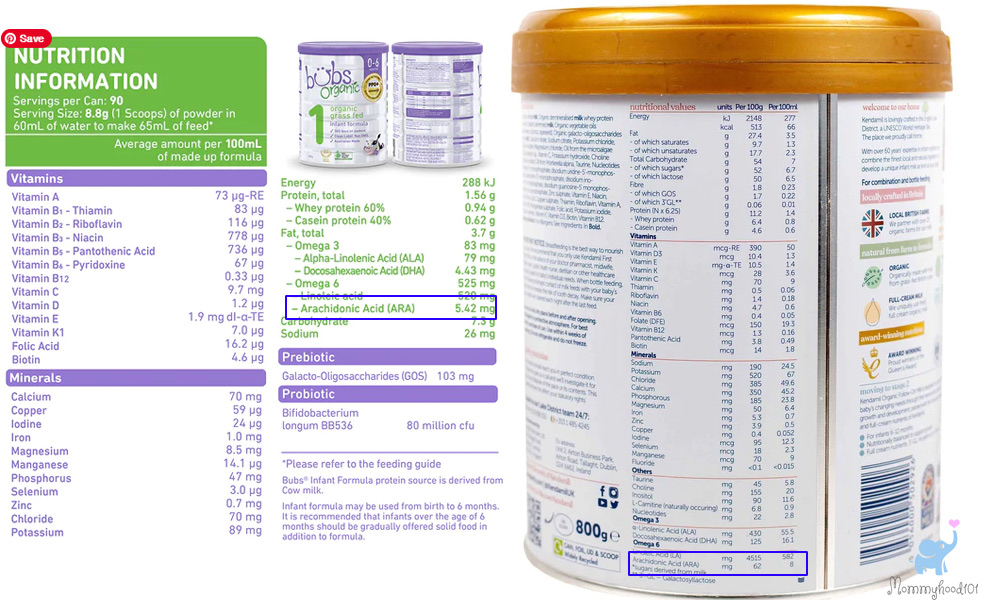
On the left is a Bubs formula label, showing 5.4 mg ARA per 100mL of prepared formula.
On the right is a Kendamil organic formula label, showing 8mg of ARA per 100mL of prepared formula.
Benefits of ARA for Infants
There are four primary reasons why ARA is included in infant formula:
- ARA is found naturally in breast milk.
- Conversion of linoleic acid (LA) to ARA is not sufficient for infant needs.
- Circulating levels of ARA in breastfed infants can be matched with formula when it contains added ARA.
- Child development is influenced by the ratio of DHA to ARA in infant formula.
Around the world, ARA levels in breast milk are higher than that of DHA (in some cases, twice as high).
The Early Nutrition Academy, World Association of Perinatal Medicine, and the Child Health Foundation recommend that the level of ARA in infant formula be equivalent to the level of DHA in infant formula (0.20 to 0.50 weight percent of total fat).
In general, the research demonstrating the benefits of DHA in baby formula is more compelling than the research examining ARA in baby formula.
That said, there are some benefits to immune function, nervous system development, and cardiovascular function that are worth reviewing.
There are five primary sources of ARA for a developing fetus and infant:
- During pregnancy, the mother provides ARA to the fetus through the placenta.
- During breastfeeding, the mother provides ARA to the infant through breast milk (about 0.5% of the fatty acids in breast milk is ARA).
- During formula feeding, the formula provides ARA to the infant through the addition of natural and/or synthetic sources.
- During solid food eating, certain foods naturally provide small amounts of ARA to the infant, especially red meat.
- After the first few years of life, children can synthesize their own ARA from linoleic acid (LA).
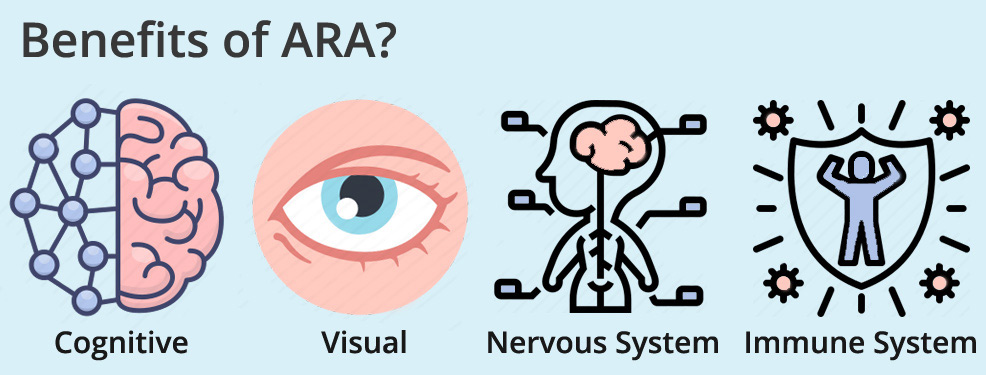
Below are some of the potential benefits of ARA.
Cognitive Development
In studies examining the effects of ARA on infants' cognitive development, most studies combine ARA with DHA.
This design makes it difficult to understand which fatty acid is producing any benefits to cognitive function.
There are some studies, however, that compare DHA alone versus DHA and ARA. These studies show mixed results:
- One study showed that babies fed formula with DHA and ARA had higher verbal intelligence at 4 years old relative to those who were fed formula with DHA only.
- One study showed higher mental development scores (on the Bayley mental development index II) at 18 months of age when ARA and DHA are included in formula, versus DHA alone.
- However, other studies show no differences in cognitive development between DHA alone versus DHA and ARA.
- ARA levels in umbilical cord are positively associated with neurological evaluation scores.
- Most studies find no difference in any cognitive or neurodevelopmental measure when comparing babies fed formula containing DHA alone versus DHA plus ARA.
In general, scientists tend to agree that DHA is the more important fatty acid.
Scientists also tend to believe that the ratio of DHA to ARA matters, and that ARA content should always be higher than DHA content.
Visual System Development
In studies examining the effects of ARA on infants' visual system development, most studies combine ARA with DHA, making it difficult to know which of these two ingredients is important.
Some studies, however, compare DHA alone to supplementation with both DHA and ARA.
According to large-scale reviews of this literature, there is no evidence that including ARA benefits visual development relative to DHA alone.
Physical Development
Studies examining the relationship between ARA and physical development have found a few important findings.
- Higher movement quality at 12 weeks when breastfeeding moms are supplemented with ARA and DHA, versus DHA alone.
- Blood levels of ARA are correlated with measures of normal growth through 12 months of age.
- Most studies find no difference in any growth measure when comparing babies fed formula containing DHA alone versus DHA plus ARA.
Immune System Development
A mature immune system reduces susceptibility to infection and reduces the likelihood of developing allergies to food and other environmental exposures.
ARA is an important constituent of cell membranes, providing it with flexibility and fluidity, which is important for immune function.
It is well known that arachidonic acid (ARA) in adults is related to healthy nervous system function, skeletal muscle, and immune function (through its role in eicosanoid synthesis).
But with infants, that evidence is much weaker.
- Some studies suggest that low DHA levels in infants are associated with atopic allergy, but this effect is not seen with ARA, suggesting that ARA is more helpful for immune function.
- A systematic review suggested there is no good evidence that ARA supplementation in formula affects immune function independently of DHA supplementation.
Thus, while ARA does appear to be important for healthy adults, there is no compelling evidence that including ARA in infant formula affects immune function.
However, some scientists argue that because most of the evidence for DHA's positive effects is derived from studies that supplement with both DHA and ARA, that ARA should be considered an important component of the fatty acid composition. At least until studies are conducted comparing ARA alone, DHA alone, and the two combined.
Sources of ARA in Baby Formula
There are three primary sources of ARA in baby formula:
- Mortierella Alpina (M. alpina) fungal oil (containing at least 40% ARA).
- Egg phospholipids, however we are not aware of any infant formulas that use this.
- Undisclosed ARA sources, wherein formulas simply list "arachidonic acid" as an ingredient without disclosing its source.
Mortierella Alpina is generally recognized as safe (GRAS) by the U.S. FDA, Health Canada, Food Standards of Australia and New Zealand (FSANZ), and/or the European Union.
ARA sourced from Mortierella Alpina is manufactured in a laboratory. This involves extracting the oils from a fermented lab-grown fungus (shown in the below image).
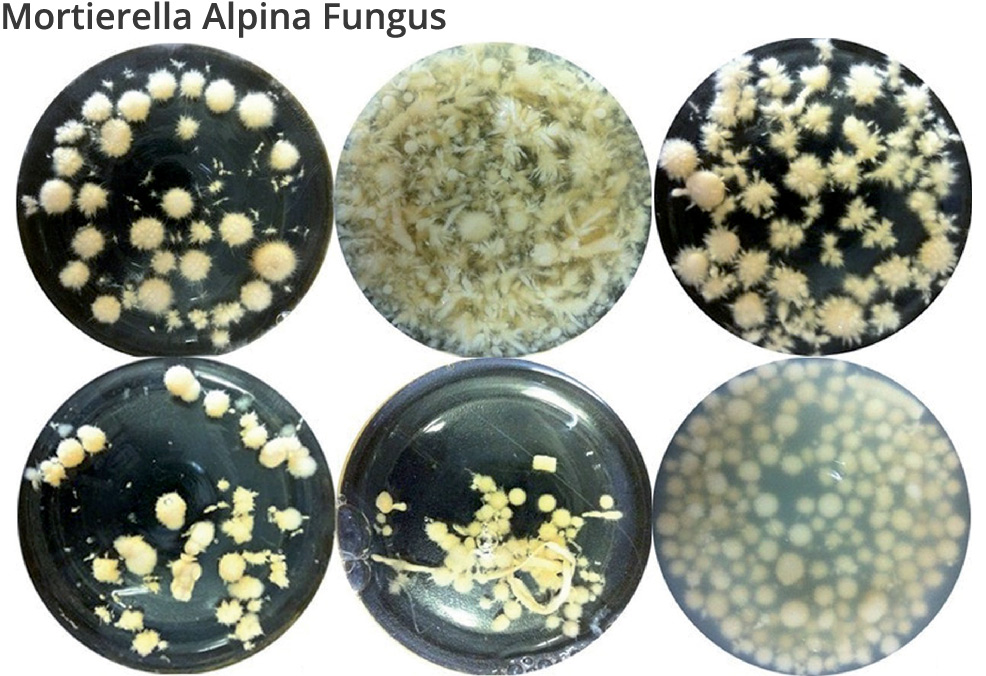
It doesn't look very appetizing, but the oils that get extracted from Mortierella Alpina are a great source of ARA!
Hexane Used in ARA Extraction?
Some parents and third parties have raised concerns that ARA from fungal oils is manufactured using the toxic solvent hexane (and in some cases, ethyl acetate).
Specifically, the ARA oils are extracted from fermented Mortierella Alpina by blending with hexane.
The hexane is then removed through a distillation or vacuum evaporation process.
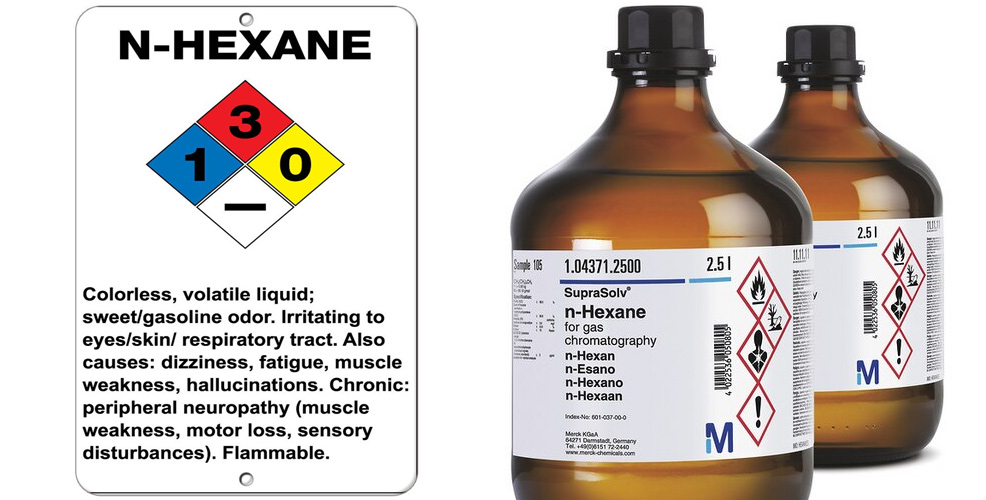
While there is no evidence to suggest that hexane is present in baby formulas at levels that would be harmful to infant health or development, some believe that even trace amounts are cause for concern. For example, they believe that these oils should not be included in organic baby formulas, and that they cause diarrhea and other gastrointestinal side effects (see a strongly biased report here).
In fact, when studying the specifications of ARA-rich oils provided to the U.S. FDA, independent testing shows that the level of residual solvents in these oils is below 1.0 milligrams per kilogram. There are one million milligrams in a kilogram, which means that residual solvents are present at a level of lower than one part per million.
This is why the FDA considers ARA-rich oils as GRAS (generally regarded as safe).
In any case, due to the concern over potential hexane content, many international food standards set maximum hexane levels for infant formula.
For example, the Food Standards of Australia and New Zealand (FSANZ) set a maximum hexane concentration (in mg/kg) of 0.3 in fatty acid-rich oils (including Mortierella Alpina). This means that in 6 ounces of prepared baby formula, the maximum hexane trace content would be about 0.008mg (or 8 micrograms).
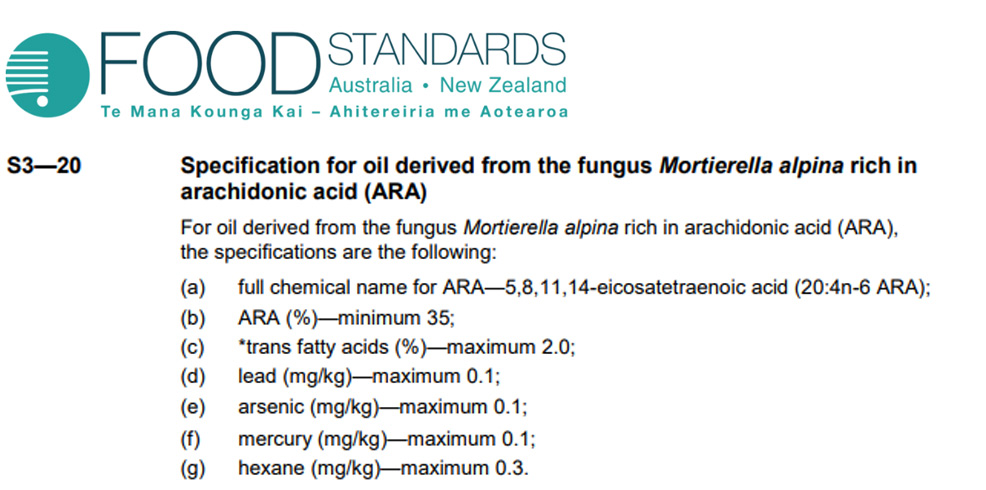
In another example, the European Commission does not allow fatty acid-rich oils to be included in baby formula if they have used hexane extraction methods.
Martek Biosciences, a leading manufacturer of fungal oils (such as their life'sARA product), notes in their manufacturing information that "no detectable residues of extraction solvents, pesticide residues, PCB's or any heavy metals such as arsenic, mercury, cadmium and lead" can be found in their oils.
However, the manufacturer has not disclosed the results of these tests to the public. Nor do we know the detection methods used or their sensitivity.
Thus, while we are not aware of any evidence that baby formulas using these oils contain trace amounts of hexane, more sensitive methods such as accelerator mass spectrometry could find residual hexane in the future. In the meantime, some scientists have called for new extraction methods to reduce the use of potentially harmful solvents.
How Much ARA Should be in Baby Formula?
The American Academy of Pediatrics (AAP) recommends that infants have a DHA intake of 0.35% of total fatty acids consumed, but makes no concrete recommendations regarding ARA intake.
In Europe, the European Academy of Pediatrics and the Child Health Foundation recommend that infant formulas contain ARA at the same (or higher) level than DHA content.
Using these data, we can ascertain that baby formula should contain approximately 10-15mg of ARA in 100mL (or 3.4 ounces) of prepared formula, and this amount should at least match the amount of DHA.
ARA in Baby Formula vs. Breast Milk
Breast milk naturally contains ARA, making it the best possible source of nourishment. We all know that breast is best!
However, ARA in baby formula is intended to bridge the traditional nutritional gap for formula-fed infants.
No baby formula can precisely emulate breast milk and its inherent advantages. In this manner, while the ARA content of infant formula might be similar to that of breast milk, infant formula is still highly dissimilar to breast milk in several ways.
We are still a long way off from replicating the unique enzymes, antibodies, white blood cells, amino acids, and prebiotics found in breast milk.
Side Effects & Precautions
ARA-enriched baby formula is generally safe for infants, and most infants will not experience any adverse side effects from consuming it.
However, some babies may experience mild digestive issues, such as gas, bloating, or diarrhea.
If you notice any adverse reactions, consult your pediatrician for guidance; they might have some good advice about how to mitigate or avoid its impact on your little one.
Storage & Handling
Always read the manufacturer's instructions for the proper storage and handling of baby formula.
This will help keep the formula fresh and avoid premature degradation of ingredients with relatively low stability profiles (such as ARA).
In general, storage and handling guidelines do not vary as a function of whether or not the formula includes ARA.
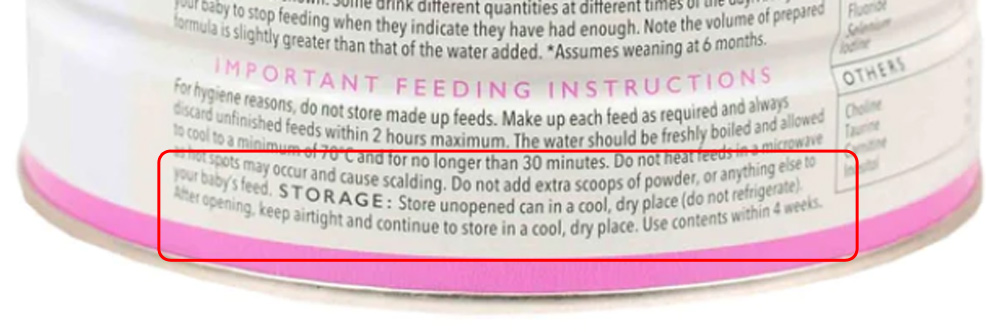
Most baby formulas will recommend storing the unopened formula can in a cool, dry place (and not putting it in the refrigerator). Once the formula is opened, they usually recommend keeping the can sealed airtight (the lid securely closed) and continuing to store it in a cool, dry place (and not in the refrigerator).
Most baby formulas also recommend using the formula within 3-4 weeks of opening, but be sure to read the label because it varies by manufacturer!
Conclusions
In conclusion, arachidonic acid (ARA) may play an important role in infant nutrition and development, but it is difficult to know whether any such effects are independent of DHA.
As an essential omega-6 fatty acid, ARA likely plays a vital role in the growth and maturation of the nervous system, immune function, and overall cellular processes.
While ARA is naturally present in breast milk, its inclusion in baby formula seeks to bridge nutritional gaps for formula-fed infants.
While ongoing research continues to shed light on its effects, it's important to note that ARA-enriched formulas are generally safe for infants, although some mild digestive issues may occur in some cases.
Finally, it is likely that the ratio of ARA to DHA content is important, and many organizations and scientists recommend that infant formulas contain both (at equal levels, or with higher ARA than DHA).
Scientific References
Brenna, J. T. (2016). Arachidonic acid needed in infant formula when docosahexaenoic acid is present. Nutrition reviews, 74(5), 329-336.
Carlson, S. E., Werkman, S. H., Peeples, J. M., Cooke, R. J., & Tolley, E. A. (1993). Arachidonic acid status correlates with first year growth in preterm infants. Proceedings of the National Academy of Sciences, 90(3), 1073-1077.
Dijck-Brouwer, D. J., Hadders-Algra, M., Bouwstra, H., Decsi, T., Boehm, G., Martini, I. A., ... & Muskiet, F. A. (2005). Lower fetal status of docosahexaenoic acid, arachidonic acid and essential fatty acids is associated with less favorable neonatal neurological condition. Prostaglandins, leukotrienes and essential fatty acids, 72(1), 21-28.
Hadley, K. B., Ryan, A. S., Forsyth, S., Gautier, S., & Salem Jr, N. (2016). The essentiality of arachidonic acid in infant development. Nutrients, 8(4), 216.
Hoffman, D. R., Boettcher, J. A., & Diersen-Schade, D. A. (2009). Toward optimizing vision and cognition in term infants by dietary docosahexaenoic and arachidonic acid supplementation: a review of randomized controlled trials. Prostaglandins, Leukotrienes and essential fatty acids, 81(2-3), 151-158.
Lauritzen, L., Fewtrell, M., & Agostoni, C. (2015). Dietary arachidonic acid in perinatal nutrition: a commentary. Pediatric Research, 77(1), 263-269.
Lien, E. L., Richard, C., & Hoffman, D. R. (2018). DHA and ARA addition to infant formula: Current status and future research directions. Prostaglandins, Leukotrienes and Essential Fatty Acids, 128, 26-40.
Lucas, A., Stafford, M., Morley, R., Abbott, R., Stephenson, T., MacFadyen, U., ... & Clements, H. (1999). Efficacy and safety of long-chain polyunsaturated fatty acid supplementation of infant-formula milk: a randomised trial. The Lancet, 354(9194), 1948-1954.
Miles, E. A., Childs, C. E., & Calder, P. C. (2021). Long-chain polyunsaturated fatty acids (LCPUFAs) and the developing immune system: a narrative review. Nutrients, 13(1), 247.
Tounian, P., Bellaïche, M., & Legrand, P. (2021). ARA or no ARA in infant formulae, that is the question. Archives de Pédiatrie, 28(1), 69-74.
Uauy, R., Hoffman, D. R., Mena, P., Llanos, A., & Birch, E. E. (2003). Term infant studies of DHA and ARA supplementation on neurodevelopment: results of randomized controlled trials. The Journal of pediatrics, 143(4), 17-25.
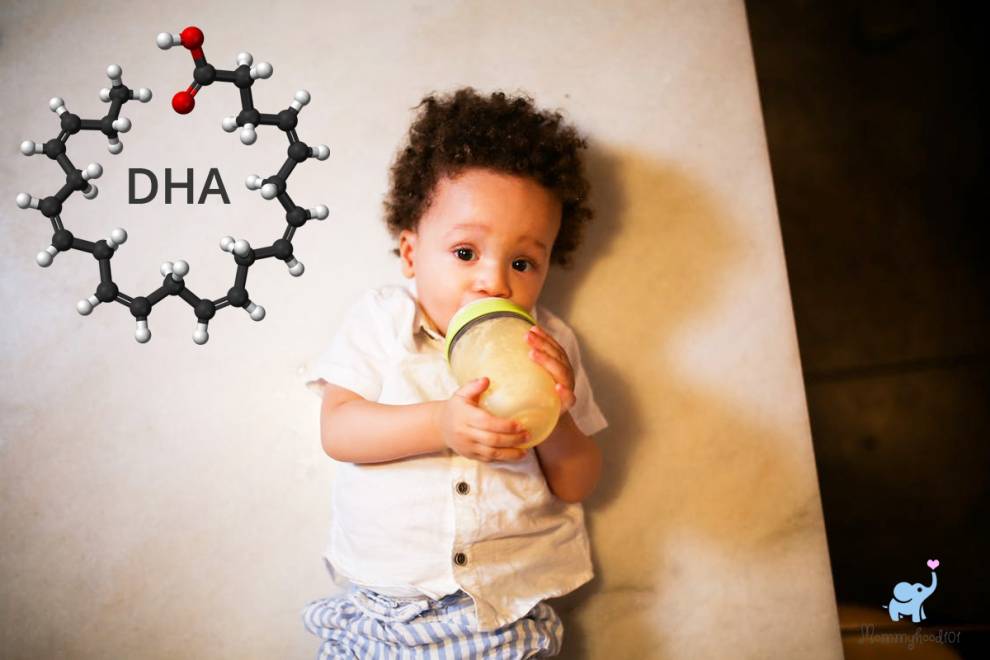
DHA in Baby Formula: Everything you Need to Know
DHA is an important Omega-3 fatty acid found in baby formula. Learn about how DHA is...

Breastfeeding: How to Increase Milk Supply
Breastfeeding is a journey with a greater learning curve than many new mothers expect....

Best Bottle Warmers of 2024, Tested & Reviewed
Whether you're thawing frozen breast milk or warming prepared baby formula or baby food...
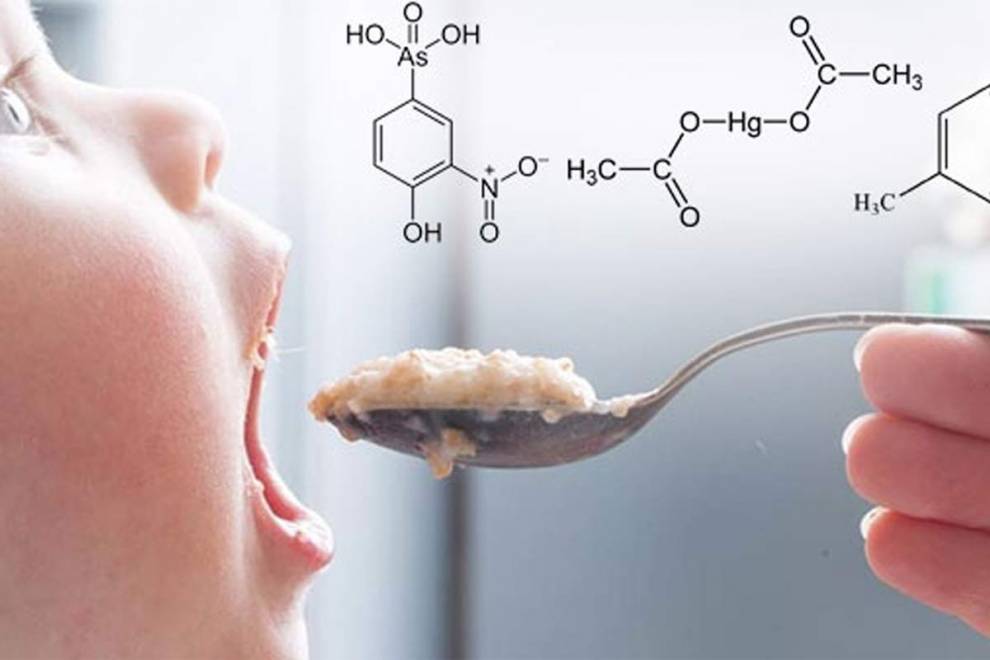
Baby Foods and Formulas Without Heavy Metals? A Few Options
A study released by the non-profit Healthy Babies Bright Future (HBBF) organization is...


